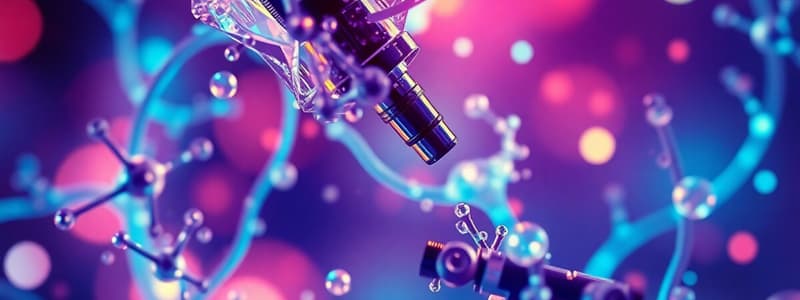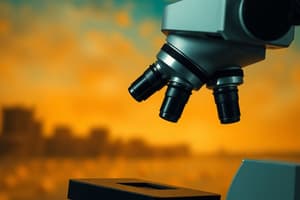Podcast
Questions and Answers
What is the best type of microscopy to observe living cells?
What is the best type of microscopy to observe living cells?
- Phase-contrast Microscopy (correct)
- Fluorescence Microscopy
- Darkfield Microscopy
- Brightfield Microscopy
A simple microscope uses multiple lenses.
A simple microscope uses multiple lenses.
False (B)
What is the term for the ability of a lens to separate or distinguish small objects that are close together?
What is the term for the ability of a lens to separate or distinguish small objects that are close together?
Resolution
The ______ of the light used is one of the major factors in resolution.
The ______ of the light used is one of the major factors in resolution.
What is the purpose of immersion oil when using a 100x objective?
What is the purpose of immersion oil when using a 100x objective?
Which type of microscopy uses beams of electrons to produce images?
Which type of microscopy uses beams of electrons to produce images?
Electron microscopy can be used to observe living organisms.
Electron microscopy can be used to observe living organisms.
Which of the following is NOT a type of light microscopy?
Which of the following is NOT a type of light microscopy?
Match the following staining techniques with their descriptions:
Match the following staining techniques with their descriptions:
Heat fixation is used to kill organisms and make them adhere to the slide.
Heat fixation is used to kill organisms and make them adhere to the slide.
What is the name of the waxy substance found in acid-fast bacteria that makes them impermeable to many staining procedures?
What is the name of the waxy substance found in acid-fast bacteria that makes them impermeable to many staining procedures?
Which type of staining uses both negative and positive staining techniques?
Which type of staining uses both negative and positive staining techniques?
Flagella staining requires a mordant to increase the thickness of flagella, making them easier to see.
Flagella staining requires a mordant to increase the thickness of flagella, making them easier to see.
What is the name of the staining procedure that is most widely used to differentiate bacteria into Gram-positive and Gram-negative groups?
What is the name of the staining procedure that is most widely used to differentiate bacteria into Gram-positive and Gram-negative groups?
Flashcards
Simple Microscope
Simple Microscope
A microscope with only one lens, typically used for initial observations.
Compound Microscope
Compound Microscope
A microscope with multiple lenses, providing higher magnification.
Ocular Lens
Ocular Lens
The lens in the eyepiece of a microscope that magnifies the image.
Objective Lens
Objective Lens
Signup and view all the flashcards
Condenser Lens
Condenser Lens
Signup and view all the flashcards
Total Magnification
Total Magnification
Signup and view all the flashcards
Light Microscopy
Light Microscopy
Signup and view all the flashcards
Electron Microscopy
Electron Microscopy
Signup and view all the flashcards
Transmission Electron Microscopy (TEM)
Transmission Electron Microscopy (TEM)
Signup and view all the flashcards
Scanning Electron Microscopy (SEM)
Scanning Electron Microscopy (SEM)
Signup and view all the flashcards
Refractive Index
Refractive Index
Signup and view all the flashcards
Resolution
Resolution
Signup and view all the flashcards
Brightfield Microscope
Brightfield Microscope
Signup and view all the flashcards
Darkfield Microscopy
Darkfield Microscopy
Signup and view all the flashcards
Phase-Contrast Microscopy
Phase-Contrast Microscopy
Signup and view all the flashcards
Fluorescence Microscopy
Fluorescence Microscopy
Signup and view all the flashcards
Fixation
Fixation
Signup and view all the flashcards
Staining
Staining
Signup and view all the flashcards
Gram Stain
Gram Stain
Signup and view all the flashcards
Acid-fast Stain
Acid-fast Stain
Signup and view all the flashcards
Capsule Stain
Capsule Stain
Signup and view all the flashcards
Endospore Stain
Endospore Stain
Signup and view all the flashcards
Flagella Stain
Flagella Stain
Signup and view all the flashcards
Study Notes
Light Microscopy
- Phase-contrast microscopy is the best type of microscopy for observing living cells.
- A simple microscope uses a single lens.
- Resolution is the ability of a lens to separate or distinguish small objects that are close together.
- The wavelength of the light used is one of the major factors in resolution.
- Immersion oil is used to prevent the loss of light that occurs when light passes from glass to air.
- Electron microscopy uses beams of electrons to produce images.
- Electron microscopy cannot be used to observe living organisms because the electron beam is too damaging.
- Darkfield microscopy is not a type of light microscopy.
Staining Techniques
- Heat fixation is used to kill organisms and make them adhere to the slide, allowing for further staining.
- Mycolic acid is the waxy substance found in acid-fast bacteria that makes them impermeable to many staining procedures.
- Capsule staining uses both negative and positive staining techniques.
- Flagella staining requires a mordant to increase the thickness of flagella, making them easier to see.
- Gram staining is the most widely used staining procedure to differentiate bacteria into Gram-positive and Gram-negative groups.
Studying That Suits You
Use AI to generate personalized quizzes and flashcards to suit your learning preferences.



